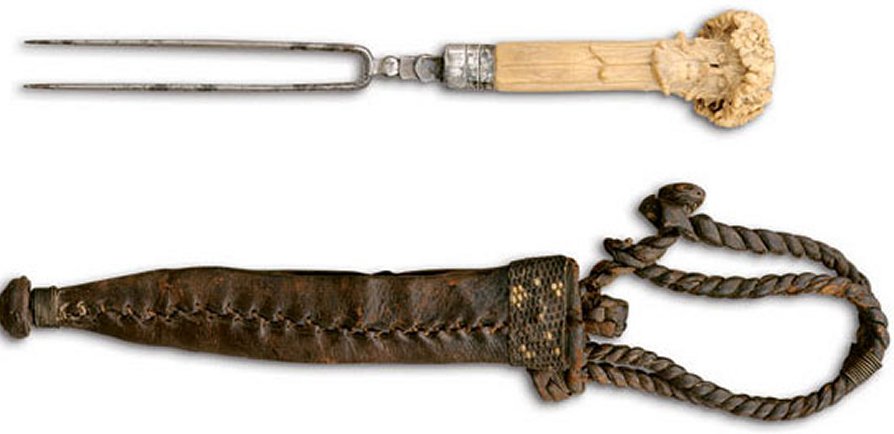Troublesome Ancient History Of Forks That Were Long A Shocking Sensation
A. Sutherland - AncientPages.com - Should you eat the food using five or three fingers? You should use a fork. At the beginning, a fork did not gain many enthusiasts in Europe.
 Fork and leather case. Southern Germany or Austria, mid-18th century. Image via cooperhewitt.org
Fork and leather case. Southern Germany or Austria, mid-18th century. Image via cooperhewitt.org
What is the history of the fork?
When the first forks appeared, they caused a sensation, but getting people to use them for eating was not easy. Not only were forks very expensive, but they even had a number of enemies, and one of them was the Church, which banned the use of the fork.
The Church disliked forks and argued that God had created humans with fingers so they could touch and eat God’s food. The Church’s disapproval did not stop people from producing gold and silver forks that wealthy families in Tuscany wanted to have at the dining table.
Still, many people did not know how to use them. For many, the fork was still considered a strange, dangerous, and very useless tool and could not gain much popularity.
This situation lasted until the 15th century, and it was the time when Europeans found that cutlery did not have much to do with the devil. However, it has gained popularity because the spoon played the most important role at the time, and solid foods were eaten with the help of the hand.
Forks appeared only at the royal and magnate courts in Italy. A century later, the fork arrived in France and had only two teeth used to impale the meat. Later, the fork gained a third tooth – a sign of the commonly used method of eating with three fingers. Gradually, different varieties of this cutlery were created. One such fork was shaped in the form of a cake fork.
Old etiquette books advised people not to eat soup with a fork. So, one can imagine how confused people must have been when a fork was put on the dining table.
Forks molded bronze and stamped decoration excavated in the remains of the ancient city of Susa. Musée du Louvre. Image credit: Marie-Lan Nguyen - Public domain
Ancient people ate with their fingers. You could do it the right or wrong way. How many fingers were used for eating was one of the marks that distinguished the upper and lower classes.
The most common was to grab the food and eat it with five fingers, but from Roman times onward, eating with three fingers was considered good manners.
In the 1530s, an etiquette book even described the “three-finger rule.” People were reminded of the importance of using the correct number of fingers when dining in a good society.
Tableware was long unheard of. The use of forks for eating had yet to be considered.
The oldest forks were discovered in Çatalhöyük (eller Çatal Hüyük), Turkey. Scientists dated the artifacts to the fourth millennium B.C., but researchers concluded it was unlikely the primitive forks were used for eating. It is more likely they were used as ancient tools. Some Persian nobility may have used a forklike tool in the eighth or ninth century.
Copper alloy fork; two pronged and decorated; twisted ergonomic handle grip with oval section, ending in a miniature head of a horned animal and, at the other, a pair of tines with ovoid-circular sections. Late Sasanian. 6thC-7thC - Excavated by: George Smith - South West Palace (Nineveh). Length 20.2, width 2.40 cm - From Kuyunjik, Nineveh in northern Iraq. Image source: British Museum
The word “fork” comes from the Latin furca, a farmer’s pitchfork. It was first used for eating in the 11th century in Tuscany, Italy.
The fork was a shocking sensation for at least a hundred years.
Before being murdered, Thomas Becket, Archbishop of Canterbury, introduced the fork to England and King Henry II, but Englishmen were not impressed and sometimes even suspicious.
According to some legends, noblemen at the court used the forks for dueling. Whether this is true or just a myth has yet to be discovered.
Steel French forks dating from the late 1500s to the early 1600s, with mother-of-pearl and beads. Image credit: V&A MuseumWhat is historically confirmed is that the fork was an expensive, decorative curiosity from Italy, and few could afford it.
King Edward I owned thousands of royal knives and hundreds of spoons but only seven forks. Six of these were made of silver, and one was of gold. King Charles V of France owned 12 forks.
Forks were not readily accepted in Europe. They were expensive, often ridiculed, and many needed help with how and when to use them. In popular etiquette books, advice was given: “Do not try to eat soup with a fork.”
Only in the 18th century did forks become accepted at the dining table—more and more families, even from the poorer classes, owned forks.
Today, we find it hard to imagine we can eat dinner without a fork, but not so long ago, the situation was much different.
Written by – A. Sutherland AncientPages.com Staff Writer
Copyright © AncientPages.com All rights reserved. This material may not be published, broadcast, rewritten or redistributed in whole or part without the express written permission of AncientPages.com
Expand for referencesReferences:
Wilson B. Consider the Fork: A History of How We Cook and Eat
More From Ancient Pages
-
 Composition Of A 2,000-Year-Old Roman Perfume Identified For The First Time
Archaeology | May 26, 2023
Composition Of A 2,000-Year-Old Roman Perfume Identified For The First Time
Archaeology | May 26, 2023 -
 Peru’s Wari Culture And Their Ancient ‘Amunas’ Will Help Peru’s Water
Ancient Technology | Apr 13, 2015
Peru’s Wari Culture And Their Ancient ‘Amunas’ Will Help Peru’s Water
Ancient Technology | Apr 13, 2015 -
 Researchers Develop New Ways Of Visualizing Ancient Small Objects By Combining Technologies
Archaeology | Apr 20, 2022
Researchers Develop New Ways Of Visualizing Ancient Small Objects By Combining Technologies
Archaeology | Apr 20, 2022 -
 Cruithne: Legendary King, His Seven Sons And The First Celtic Tribe That Inhabited British Isles
Celtic Mythology | May 27, 2023
Cruithne: Legendary King, His Seven Sons And The First Celtic Tribe That Inhabited British Isles
Celtic Mythology | May 27, 2023 -
 Antisthenes And Diogenes – Founders Of Cynicism Were Ancient Greek Philosophers
Ancient History Facts | Jan 7, 2018
Antisthenes And Diogenes – Founders Of Cynicism Were Ancient Greek Philosophers
Ancient History Facts | Jan 7, 2018 -
 Aurignacians: Sophisticated And Mysterious Culture That Arrived To Levant 40,000 Years Ago – New Study
Archaeology | Nov 10, 2019
Aurignacians: Sophisticated And Mysterious Culture That Arrived To Levant 40,000 Years Ago – New Study
Archaeology | Nov 10, 2019 -
 Ancient Maya Destroyed Their Environment 2,000 Years Ago – Effects Are Still Visible Today
Civilizations | Sep 9, 2015
Ancient Maya Destroyed Their Environment 2,000 Years Ago – Effects Are Still Visible Today
Civilizations | Sep 9, 2015 -
 Isle Of May Was A Pictish Healing Center – Monks Used Herbs To Treat Sick And Dying People
Archaeology | Feb 16, 2018
Isle Of May Was A Pictish Healing Center – Monks Used Herbs To Treat Sick And Dying People
Archaeology | Feb 16, 2018 -
 Mama Pacha: Respected And Feared Supreme Goddess Of The Andean People
Featured Stories | Jul 23, 2020
Mama Pacha: Respected And Feared Supreme Goddess Of The Andean People
Featured Stories | Jul 23, 2020 -
 Mysterious Philistines: They Migrated Across Mediterranean – DNA Testing Shows
Archaeology | Jul 4, 2019
Mysterious Philistines: They Migrated Across Mediterranean – DNA Testing Shows
Archaeology | Jul 4, 2019 -
 Hatra: Ancient Powerful Caravan City That Could Withstand Invading Roman Armies
Featured Stories | Dec 12, 2020
Hatra: Ancient Powerful Caravan City That Could Withstand Invading Roman Armies
Featured Stories | Dec 12, 2020 -
 Humans Have Been Predicting Eclipses For Thousands Of Years, But It’s Harder Than You Might Think
Archaeology | Apr 20, 2023
Humans Have Been Predicting Eclipses For Thousands Of Years, But It’s Harder Than You Might Think
Archaeology | Apr 20, 2023 -
 Skull Discovered In Ancient City Of Euromus Shows Neurosurgery Performed 2,200 Years Ago
Archaeology | Aug 2, 2019
Skull Discovered In Ancient City Of Euromus Shows Neurosurgery Performed 2,200 Years Ago
Archaeology | Aug 2, 2019 -
 A 200-Year-Old Swedish Mystery Remains Unsolved
Ancient Mysteries | Oct 7, 2015
A 200-Year-Old Swedish Mystery Remains Unsolved
Ancient Mysteries | Oct 7, 2015 -
 DNA Study Suggests Human Language Emerged 135,000 Years Ago
DNA | Mar 14, 2025
DNA Study Suggests Human Language Emerged 135,000 Years Ago
DNA | Mar 14, 2025 -
 Mysterious Jomsvikings: Fearless Scandinavian Warrior-Brotherhood
Featured Stories | Apr 26, 2016
Mysterious Jomsvikings: Fearless Scandinavian Warrior-Brotherhood
Featured Stories | Apr 26, 2016 -
 Mysterious Biblical Canaanites – What Ancient DNA Reveals About Their Fate
Archaeology | Jul 28, 2017
Mysterious Biblical Canaanites – What Ancient DNA Reveals About Their Fate
Archaeology | Jul 28, 2017 -
 Polynesian Stonehenge: Enigmatic Ha’amonga ‘a Maui Trilithon Of Tonga
Civilizations | Sep 11, 2018
Polynesian Stonehenge: Enigmatic Ha’amonga ‘a Maui Trilithon Of Tonga
Civilizations | Sep 11, 2018 -
 Gothic Warrior With Rare Sword Unearthed In Thessaloniki, Greece
Archaeology | Apr 23, 2021
Gothic Warrior With Rare Sword Unearthed In Thessaloniki, Greece
Archaeology | Apr 23, 2021 -
 Mysterious Ancient Lost Civilization Of North America Had Interest In One Particular Constellation
Ancient Mysteries | Apr 17, 2018
Mysterious Ancient Lost Civilization Of North America Had Interest In One Particular Constellation
Ancient Mysteries | Apr 17, 2018



